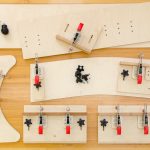We may receive a commission when you use our affiliate links. However, this does not impact our recommendations.
When traveling, there are many times when I wish for a toothed planing stop, especially when installing stuff where I rarely even have a bench. Enter the Whipple Hook from Lee Valley Tools.
This early 20th-century patented $9.50 gizmo turns any wooden surface into a functional planing stop with the addition of two screws (so don’t use this in your hotel room).
This week I installed it on the corner of a workbench in my shop and have used it to plane up a bunch of chair and stool parts. For a jobsite tool (and only $9.50), it’s quite a bargain. It’s well-made from stainless steel. The teeth are sharp out of the box. There’s almost nothing to complain about.
But I do have a couple nits to pick. I wish the two main installation holes weren’t lined up exactly with one another. If you use long screws (longer than 1-1/4”) the screw tips will collide. Also, I wish the steel were a little more springy. Once you use a screw to lower the planing stop, it’s not eager to spring back without a little gentle bending.
Both of these details are minor compared to the overall utility of the piece – I’m putting one in the truck next to my extra tape measures, jobsite saw and screwdrivers.
Some more details:
When you install the hook, I recommend #10 round-head screws for holding the hook in place. As you can see, I used brass screws for this part with no problem. For the screw that adjusts the height of the planing stop, definitely go for a #10 steel screw because you’ll be manipulating it quite a bit.
The crochet for the front of the bench will grab boards inside its teeth that are 9/16” or thinner. Thicker boards butt against the teeth. To hold the rear end of the board, a bar clamp is ideal. (You also might be able to rig a stop below by adding a clamp to the leg of the table you’re working on.)
The planing stop works very well for boards 6” wide and narrower. For wider boards you’ll need some sort of bracing on the side of your board to prevent the board from spinning off the bench (check out the doe’s foot bench appliance for this).
All in all, it’s a great piece of kit for less than $10.
— Christopher Schwarz
Here are some supplies and tools we find essential in our everyday work around the shop. We may receive a commission from sales referred by our links; however, we have carefully selected these products for their usefulness and quality.














I am sure this is a great solution for some but if I installed one I am sure it would take me no time to gouge out large chunks of my body and spread blood hither and yon about my shop. {|8-)>— Maybe a leather covering might avoid a trip to the ER.
Well I am a messed up leftie. I plane like a rightie. But the whipp… looks like it could be put on the right end of a bench and work fine. You might have to flatten one side a bit for thinner boards.
Speaking only for myself, I plane right. Would love one of these as I have yet to build my first real bench. If they made a left-handed version, that would make my day. Alas.
Well, I guess that’s just more motivation to finally get the wood and build the darn bench!
The planing stop works very well for boards 6” wide and narrower for wider boards you’ll need…
I’m thinking there’s a comma that should be inserted somewhere in this sentence, but I’m not exactly sure where. Or perhaps I’m reading it all wrong. Please advise.
Spoiler Alert! This is for right-handed use only! Lefties not welcome!